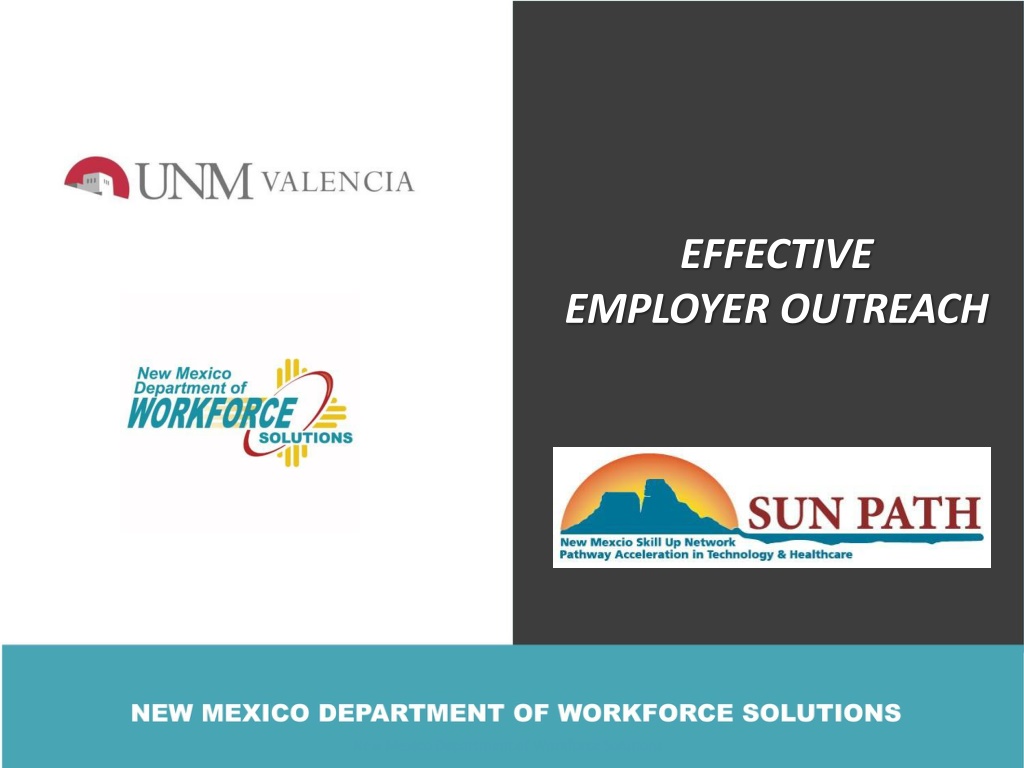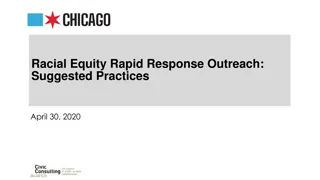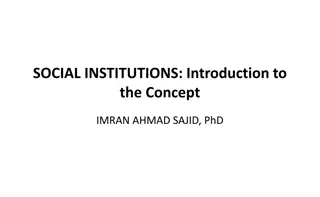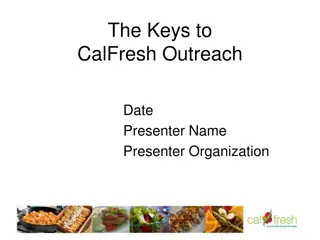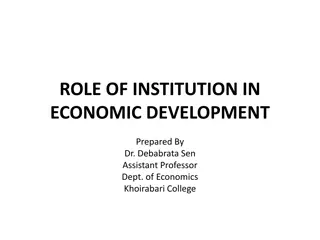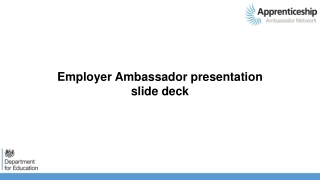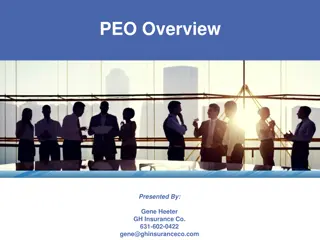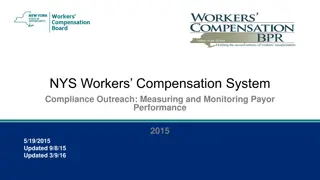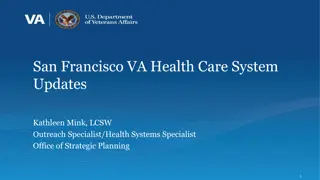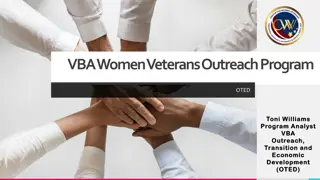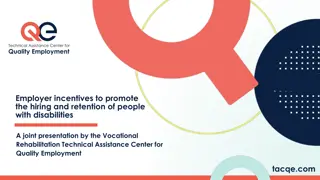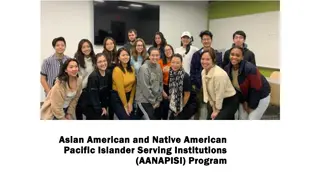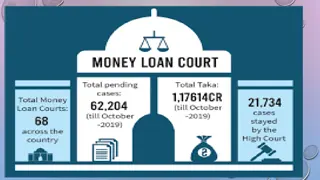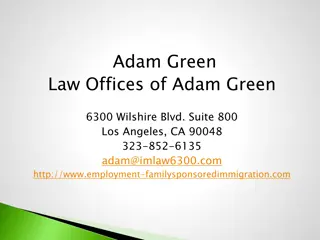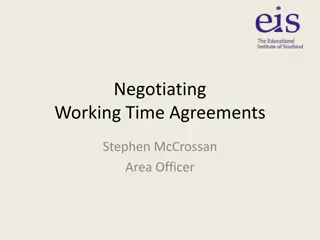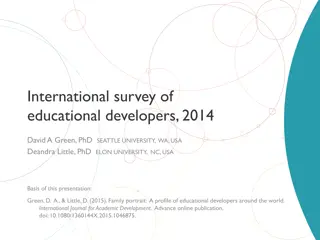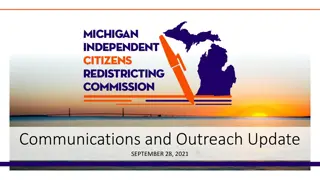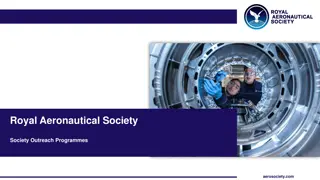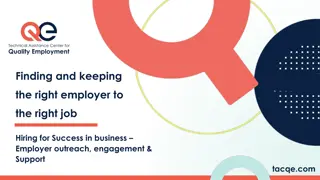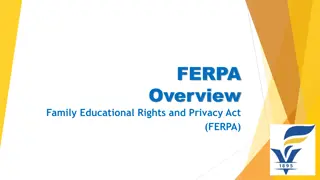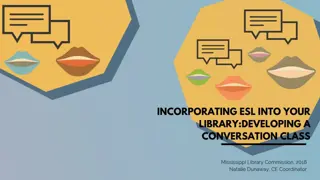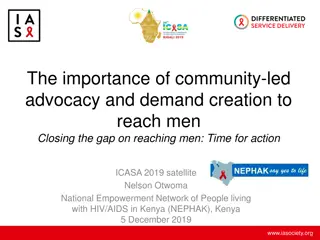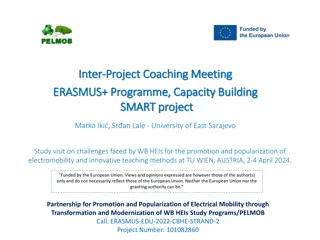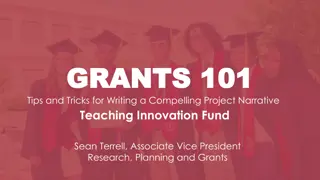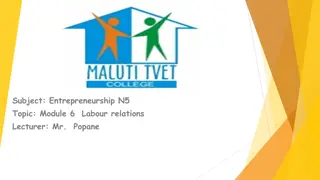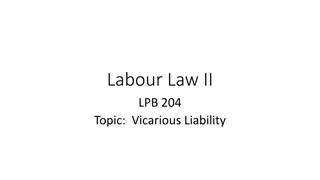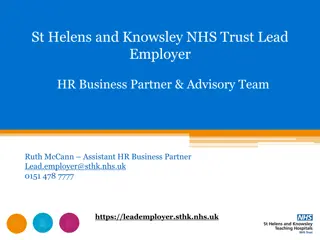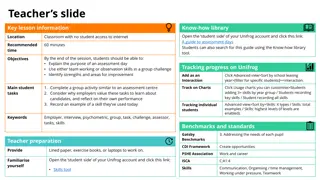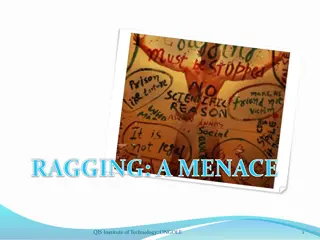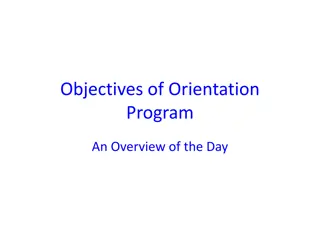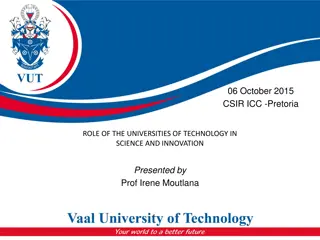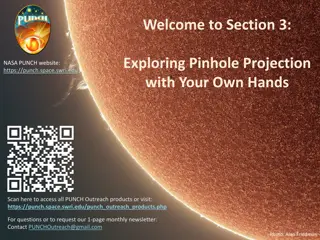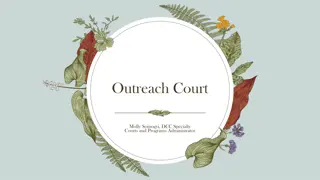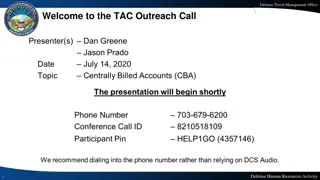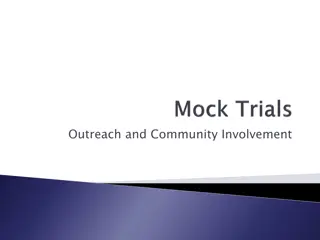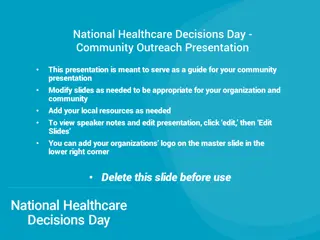Innovative Strategies in Employer Outreach for Educational Institutions
Explore effective employer outreach approaches and outcomes for educational institutions in New Mexico, focusing on employer relations, skills match gap closure, advisory councils, program development examples, and successful student placements in relevant roles. Discover how connecting employers to students can enhance recruitment outcomes.
Download Presentation

Please find below an Image/Link to download the presentation.
The content on the website is provided AS IS for your information and personal use only. It may not be sold, licensed, or shared on other websites without obtaining consent from the author. Download presentation by click this link. If you encounter any issues during the download, it is possible that the publisher has removed the file from their server.
E N D
Presentation Transcript
EFFECTIVE EMPLOYER OUTREACH New Mexico Department of Workforce Solutions
EFFECTIVE EMPLOYER OUTREACH APPROACH, PROCESS, and OUTCOMES. Please save all questions or comments till after the presentation. THINK OUTSIDE THE BOX WITH YOUR EMPLOYER OUTREACH EFFORTS.
EMPLOYER RELATIONS & RECRUITMENT SERVICES Employers are both vital partners in the educational process and primary customers for College and University career services. Career services that assist employers to not only connect with students, but doing so in a targeted manner, also will have more productive recruitment partnerships.
CLOSING THE SKILLS MATCH GAP Higher education is about more than getting a job. The investments that individual students and society overall make in higher education have important civic and academic benefits. But we can do a better job of making sure more students are achieving better career benefits as well. If we re ever going to move the needle in the jobs crisis, we need to close the skills match gap in a way that is scalable and sustainable, and we must provide a better return on education for everyone.
ADVISORY COUNCILS Our process on developing a new program: Meet with employers in that industry. Find out what kind of training needs they have. Provide information to employers on skill sets learned in the classroom. If necessary and allowable, additional skill sets are added in order to meet the employers training needs.
EXAMPLE UNM Valencia did not have a Medical Assistant Program, but we do offer the Certified Nurse Assistant (CNA) and Phlebotomy course. Employers suggested that we combine the CNA and Phlebotomy classes along with Computers, English, Math, and Medical Terminology, as those are the skill sets that they are seeking from employees.
RESULTS Based on these recommendations, we now have a Medical Assistant program. We have had success in placing students as Nurse Techs (equivalent to a Medical Assistant) at local hospitals with these skill sets.
CONNECTING EMPLOYERS TO STUDENTS Narrowing down the recruitment pool can be accomplished by collecting regular information on employer hiring needs. Introducing faculty to employers to help establish connections with specific academic departments. Performing initial quality checks of student applicants. Connecting employers to specific student clubs, activities, events.
WITHIN THE CONTEXT OF THESE PRINCIPLES, CAREER SERVICES MUST: Develop strategic objectives for employer relations/services and job development that yield maximum opportunities for the institution s students and other designated clients. Develop, maintain, and enhance relationships with employers who may provide career development and employment opportunities for students and other designated clients.
WITHIN THE CONTEXT OF THESE PRINCIPLES, CAREER SERVICES MUST, continued: Enhance customer service and foster continuous improvement by using feedback from employers on key performance indicators and measures of services. Inform, educate, and consult with employers on the nature of services provided and student candidates availability.
EMPLOYMENT SERVICES Universities that effectively manage the transition from college to career must develop specific strategies for students personal and career development and employer engagement. For those employers who do want to engage in direct recruitment. The approach focuses on flexibility and collaboration to create a student outreach strategy that is tailored to company specifications.
EMPLOYER / STUDENT ENGAGEMENT Employers are encouraged to come to the campus and: Conduct mock interviews Meet with faculty and students Set up outreach tables in a high-traffic student area for a day Visit classrooms Engage in on-campus interviews in-person
MOCK INTERVIEWS A mock interview is a great option for students who have little interview experience (including first-year students) or for students who are concerned about their past interview performance and who want to improve.
STUDENT BENEFITS OF MOCK INTERVIEWS Reduces stress and anxiety about interviewing. Helps boost student confidence. Provides student with constructive feedback in a low-stress environment. Helps prepare for behavioral-based interview questions.
STUDENT BENEFITS OF MOCK INTERVIEWS, continued Students have appropriate questions prepared to ask the mock interviewer. Students know to be prepared for the mock interviewer's feedback following the interview. It may not all be positive (but, this is a learningexperience!). Students are advised to welcome the feedback and use it to improve their future performance.
CLASSROOM VISITS Student Benefits: Allows students to meet with actual professionals and gain real-world insights into jobs and careers in their primaryfield. Employer Benefits: Employers have the opportunity to nurture student interest in jobs and careers with their company and in their industry. Employers canalsohelp students understand the education and skill sets they need to secure jobs with theircompanies.
EMPLOYER OUTREACH INITIATIVE The Employer Outreach Initiative is building long-term, mutually beneficial partnerships with employers for all departments that will provide opportunities for students, recent graduates, and alumni. The initiative generates creative ways for employers to engage with our campus and maintain an open line of communication with thoseemployers.
EXAMPLE: SUN PATH EMPLOYER ENGAGEMENT: Job Fairs: (Workforce Connection and UNM VC) On-Campus Job Interviews: Interim Healthcare Guest Employers: Bee Hive Homes, Comfort Keepers, Interim Healthcare Mock Interviews: TriCore, Genesis Healthcare, Comfort Keepers
STUDENT ENGAGEMENT Student Engagement Through Marketing All job readiness preparation is done on a one-on-one basis. This has been very successful at our campus, because it has allowed both me and the student to establish a solid working relationship. Request current Resume or Sample Job Application. Full registration into the NM Online System (VOSS). Discuss career goals, interests, employment opportunities (Nursing facility, Hospital, Rehab,etc.). Discuss barriers towards employment(childcare, transportation,etc.).
STUDENT ENGAGEMENT, continued Creating an updated resume with new core competencies. Creating a coverletter. Exploring a full range of career and work possibilitiesthat match their careergoals. Preparing job search competencies and tools topresent themselves effectively as candidates foremployment.
STUDENT ENGAGEMENT, continued Provide resource information such as WIOA packet, Child Care application, NMDWSpublications. Provide the student the step-by-step NM Online WFC registration form with their user name and temporary password, so that they can access the system to seek employment, enter additional resumes, research labor market information,etc. Offer one-on-one job readiness sessions on Resumes, Interview prep, etc. (Can be more effective).
REMINDER ALWAYS emphasize the importance of professional development prior to a student reaching out to employers so that they have the capability to interact with employers in a mature, professional, and ultimately productive manner.
CAREER SOLUTIONS NMDWS created a powerful online career exploration and all- in-one planning website for New Mexico s youth, high school and higher education students, and job seekers. The website provides access to a comprehensive set of interactive tools that assists individuals in exploring careers, planning their future, and getting the help they need to reach for and achieve their career goals. LINK: New Mexico Department of Workforce Solutions: Career Solutions
STUDENT INTERACTION DURING THE SEMESTER Email out potential FT/PT job prospects to students throughout the semester. Email out Job Fairinformation. Reach out to students, letting them know that I am hereto support them in their jobsearch. Encourage all students to take advantage of the NM Online System and all the resources offered through NMDWS. LINK: New Mexico Workforce Connection
POST GRADUATION Exit Interview: Future Plans Employment / Education. Obtain updated contact information Follow up. Obtain new employment information.
ONGOING EMPLOYER OUTREACH: Employers are informed about the upcoming graduating students and they are encouraged to reach out to me, so that I can do my best to assist them in filling their vacant positions.
IMPLEMENTATION COMMUNICATION PLANNING RELATIONSHIP BUILDING ENGAGEMENT
COMMUNICATION PLANNING Audience Analysis Research shows that communicators who understand their audience are more successful in achieving their communicationgoals. Message Development The process of creating a customer is a process of communicating your vision and values to the right set of customers in the market. Strategic messaging facilitates this communication. Customers never buy just a product, they evaluate its value/utility and buy your vision. If an organization exists it communicates.
KEEP IT SIMPLE Target small businesses. Avoid sophisticated presentations and introductions. Collaborate with all instructors at your campuses. Educate them and let them know you are all after the same goal, to have a successful student employmentoutcome.
KEEP IT SIMPLE, continued Knock on every door. Attend job fairs and seminars related to employment. Market yourself: Invite existing employers to meet and greet yourstudents.
RELATIONSHIP BUILDING Employer Outreach Methods (Tiered Approach) LinkedIn / Facebook Email Phone Networking Events Employers Reach Out To Us
LINKEDIN / FACEBOOK LinkedIn / Facebook: Business follows relationships. I personally questioned it. But a year ago, I began to recognize its value. I d been repeatedly reaching out to key business prospects phone, email and even a personal visit. No luck. So in exasperation, I turned to LinkedIn, and discovered that one of my connections had a connection to the prospect. Through LinkedIn, the door was opened and I stepped right through it.
EMAIL When it comes to emails, follow these guidelines: Make the subject line as specific as possible. The more personal the subject line, the higher the open rate. (UNM Valencia graduate students seeking employment in Allied Health relatedpositions). Use the recipient s name. (Good afternoon Mr.Smith). If you wonder if it sounds too much like a "marketingemail , then it does sound too much like a marketing email . Always deliver in your email what you promise in your subject line (if the disconnect is too big, you re going to get good open rates but bad responses).
PHONE One of the most effective ways of securing new business is through cold calling it is a fabulous way of acquiring new leads if you do it right. The unfortunate thing is that many businesses go about their communicating the wrong way and are letting potential employers just slip through their fingers.
WHAT TO AVOID Beingunprepared. Talking too much; talking about your product before you know theneed. I know you re busy,but ... Having too many people approach the employer. Giving the employer too much information. Not listening before being forceful.
ASKING THE RIGHT QUESTIONS IS THE KEY TO YOUR SUCCESS AND SO IS ARMING YOURSELF WITH ANSWERS! Avoid yes and no questions: Are you hiring vs. tell me about your hiring processneeds. Be a problem solver: Can I share my solution vs. how canI help with thisneed? Come prepared: What is that vs. I read about that, could you highlight your biggest success with that? Add a personal touch: Is there anything else you need to know vs. that sounds interesting, what is your favorite part of yourjob?
WHY ITS REALLY ALL ABOUT SALES Be friendly andenjoyable. Fosterrapport. Be a problemsolver. Go above and beyond. Positive emotional experiences. Follow up and don t give up. Doing these things will eventually allow you to tell stories about your students and prove that they are good workers and improve youroutcome.
HOW CAN ALL OF THIS BE EFFECTIVELY MONITORED? Create a database if you don t already have one. Rate youremployers. Set a goal of how many employers to approach in a specific timeframe. Know who needs to be contacted and for what. Store and remember personal facts.
TRACKING OUTCOMES? Track success by tracking the number of opportunities that I provided for students. Opportunities are measured through: Maintaining an Excel Student Spreadsheet (Sample). Maintaining an Excel Employer Spreadsheet (Sample). Employer Follow Up and FollowThru. Job Referrals and Student InterviewOutcome. Placement Data Provided by the Employer (Start Date/Hourly Wage/Hours Per Week,etc.). Enter All Data Entry onto the NM On-Line Connection System (Case Notes, Program of Study, Activity, etc.).
INTERNSHIPS Experiential education via job shadowing and internship programs is becoming a critical part of professional development and engagement with employers. As institutions recognize that on-the-job experience is critical for students placement, it is becoming an increasingly common practice to encourage or even require internships before graduation.
ADDITIONAL OPTIONS College graduates can encounter difficulty in finding jobs because of a gap between their skill set and what employers want. To counteract this problem, it is advised for colleges to facilitatetheir students application of classroom knowledge in real world settings, and employers to realize that if they want fully prepared graduates they must invest in in house training and apprenticeship programs or similar partnerships with universities. Job Shadowing: Job shadowing provides individuals with an opportunity to spend a short period of time with a professional in a career that is of interest to them. Students are able to experience day-to-day activities as well as interact with interview professionals within a chosen careerfield.
ADDITIONAL OPTIONS, continued Finding the right opportunity can take some time and research. The following list is comprised of various websites and organizations that have historically listed or offered internships and should provide a starting point in the search for internshipopportunities.
RESOURCES LINK: New Mexico Workforce Connection United States Federal Government Internships (Dept. of State, Dept. ofEnergy, NASA, Congress and NationalLaboratories). State and Local Government Internships (State of New Mexico, Governors Internship Program, City and CountyGovernments). University Internships (Universities typically offer a wide variety of both internships and volunteeropportunities). Private Internships (Local start-ups to national corporations).
SUCCESS Success of the student is not just about the Career Coach, it is about the joint team effort of the Instructor, Career Coach, Employer, and the Student. At the end of the day it s not about me or you, it s about how well did we support, inspire, and impact the life of thestudent.
WHY CONNECT WITH NMDWS? Because we can connect business and workers with education and economic development opportunities to produce the skilled workforce necessary for NewMexico!
DISCUSSION What steps are being taken at your campus that have made an impact on the student s transition from school towork? How do you keep in touch with students throughout the semester andafterwards? Are you currently working with employers out inthe community? What is your current strategy? How is itworking? What are your processes in job development?
ACKNOWLEDGEMENTS This workforce product was funded by a grant awarded by the U.S. Department of Labor s Employment and Training Administration. The product was created by the grantee and does not necessarily reflect the official position of the U.S. Department of Labor. The U.S. Department of Labor makes no guarantees, warranties, or assurances of any kind, express or implied, with respect to such information, including any information on linked sites and including, but not limited to, accuracy of the information or its completeness, timeliness, usefulness, adequacy, continued availability, or ownership. Although the authoring institution of this educational resource has made every effort to ensure that the information presented is correct, the institution assumes no liability to any party for any loss, damage, or disruption caused by errors or omissions. Except where otherwise noted, this work by SUN PATH Consortium/University of New Mexico- Valencia is licensed under the Creative Commons Attribution 4.0 International License. To view a copy of this license, click on the following link: Creative Commons License 4.0.
